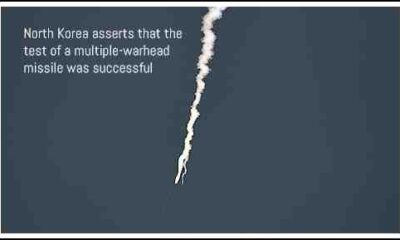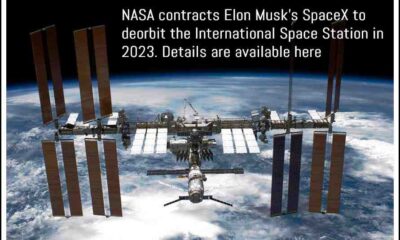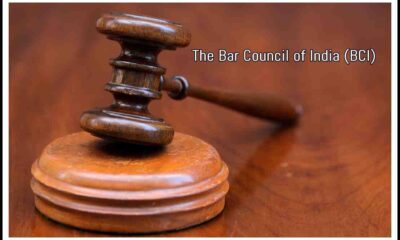CHANDRAYAAN-3
After completing another maneuver, the Chandrayaan-3 spacecraft enters a “near-circular orbit” around the moon
Published
11 months agoon

The following Chandrayaan-3 mission is scheduled to launch on August 16 at 8:30 AM IST by ISRO
Chandrayaan-3, India’s ambitious third Moon mission spacecraft, performed another maneuver on Monday that brought it even closer to the lunar surface, according to ISRO.
The spacecraft has now attained a “near-circular orbit” around the moon, according to the national space agency with its headquarters here.
After being launched on July 14, Chandrayaan-3 entered lunar orbit on August 5 and underwent two orbit lowering maneuvers on August 6 and August 9.
“The circularization phase of the orbit starts. A near-circular orbit of 150 km x 177 km was attained today thanks to a precise maneuver, the ISRO announced in a tweet.
It stated that the next procedure is scheduled on August 16 at approximately 8:30 am
As the mission advances, ISRO is performing a series of maneuvers to gradually decrease Chandrayaan-3’s orbit and place it over the lunar poles.
The spacecraft will conduct one more maneuver on August 16 to get to a 100 kilometer orbit, at which point the landing module, which includes the lander and rover, will separate from the propulsion module, according to ISRO sources.
On August 23, a soft landing on the south pole of the Moon is anticipated after the lander undergoes a “deboost” (the process of slowing down).
The ability to move the spacecraft from a horizontal to a vertical direction is the “trick we have to play” in this situation, according to ISRO Chairman S. Somnath, who stated last week that the process of bringing the lander’s velocity from 30 km height to the final landing is the most crucial phase of the landing.
Read also:-Up to 10 Years in Prison Under New Bill For Marrying Woman Under False Identity
According to him, the first velocity of the landing process is almost 1.68 km per second, however this speed is relative to the moon’s surface. The Chandrayaan 3 must become vertical because it is almost 90 degrees slanted at this location. Therefore, mathematically speaking, the entire process of turning from horizontal to vertical is quite intriguing. We’ve run numerous simulations. This is where we had a difficulty with Chandrayaan 2 earlier. Additionally, it must be assured that less gasoline is consumed, the distance computation is accurate, and all algorithms are functioning effectively.
To ensure that the necessary dispersions are managed in all of these phases—and to try to make a proper landing—”extensive simulations have been run, the guidance design has been changed, and a lot of algorithms have been put in place,” he said.
Since its launch on July 14 three weeks prior, ISRO has moved the Chandrayaan-3 spacecraft five times, placing it in ever-distancer orbits.
Then, on August 1, the spacecraft was successfully launched from Earth’s orbit toward the Moon in a crucial maneuver known as a slingshot. The Chandrayaan-3 spacecraft left its orbit around the Earth after its trans-lunar injection and started traveling in a direction that would bring it close to the moon.
In order to demonstrate end-to-end capability in safe landing and wandering on the lunar surface, Chandrayaan-3 is a follow-up mission to Chandrayaan-2.
It consists of a lander module, an indigenous propulsion module, and a rover with the aim of creating and showcasing new technology needed for interplanetary missions.
The lander and rover arrangement will be maintained until the 100 km lunar orbit thanks to the propulsion module. In order to examine the spectral and polarimetric measurements of Earth from the lunar orbit, the propulsion module contains a Spectropolarimetry of Habitable Planet Earth (SHAPE) payload.
The goals of Chandrayaan-3’s mission are to show a soft and safe lunar surface landing, lunar rover wandering, and in-situ scientific experimentation.
The lander will be able to make a soft landing at a chosen lunar location and install the rover, which will conduct in-motion chemical analysis of the Moon’s surface.
Both the lander and the rover are equipped with scientific packages that will conduct lunar surface research.
You may like
-


North Korea asserts that the test of a multiple-warhead missile was successful
-


The Student Wing of Congress storms the Exam Body NTA office and locks it from within
-


“During President Murmu’s address to Parliament, PM Modi was shown 73 times, and LoP Rahul Gandhi was shown six times”: Congress
-


NASA contracts Elon Musk’s SpaceX to deorbit the International Space Station in 2023.
-


A Caution For The CBI In The Delhi Court’s Arvind Kejriwal Custody Order
-


Bar Council of India requests that bar associations abstain from demonstrating in opposition to new criminal laws

